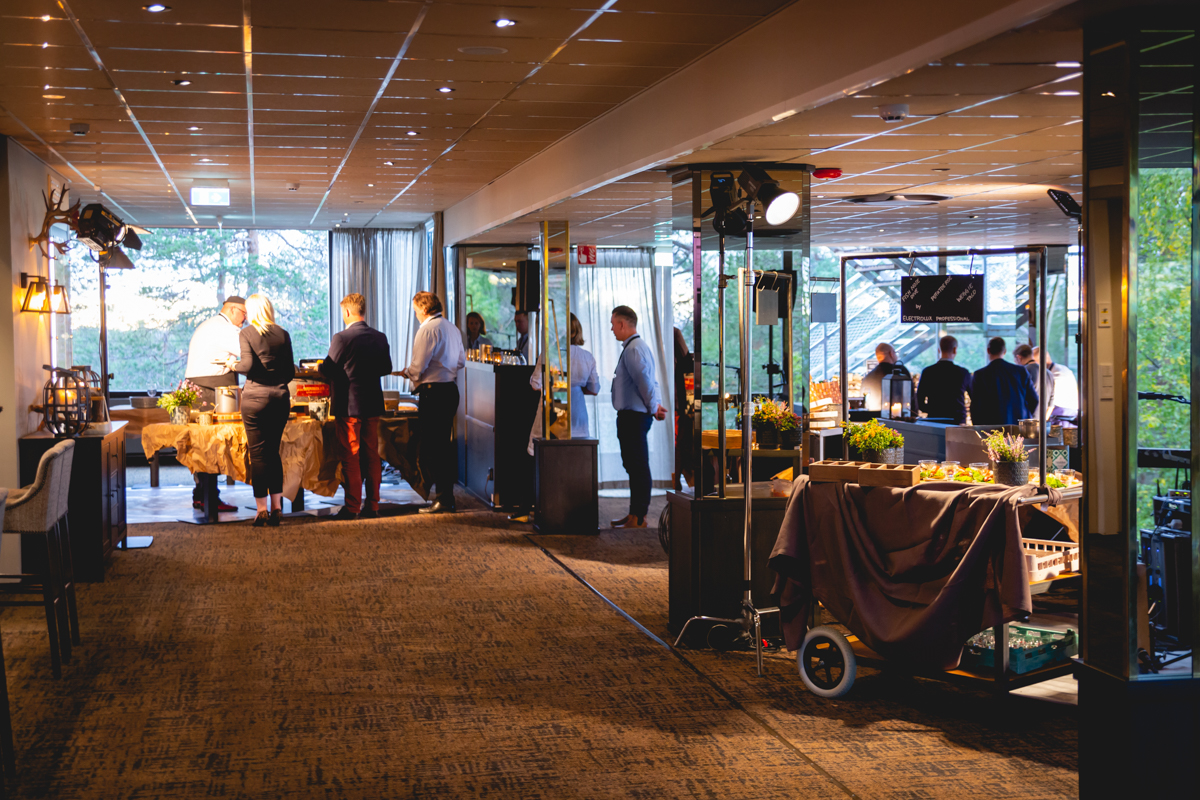Table of contents of the article
- Organising an event starts with planning
- Event production – event organisation and basics
- Event management and event technology
- Event technology
- Event security
- Event production – other issues
- For the event organiser, finally
- Summarise the objective of the event
- Event service design – the core idea
- Target groups for the event
- Event planning tool
Organising an event starts with planning
Event planning is crucial to the success of an event. The planning process involves defining the objective of the event, which helps to focus on what the event is trying to achieve. In turn, the service design of the event ensures that visitors have the most enjoyable experience possible. This includes, for example, designing the space, choosing the catering and planning the programme. Finally, defining the target audience helps to ensure that the event is interesting and relevant to the people you want to reach.
Summarise the objective of the event!
The very first step is to define the objective of the event. A good way to do this is to produce a couple of sentences summarising the core objective of the event and the target audience. It makes sense to involve several people in the definition. This may prove challenging, but it is very important. It is surprisingly common that the stakeholders who are implementing the event do not really know why the event is being organised in the first place. Everyone benefits from clarifying the core idea of the event: event marketing, event technology, performers, etc.
Event service design – the core idea
The Event Design Handbook – Systematically Design Innovative Events Using Event Canvas ( Frissen, Janssen & Luijer; BIS Publishing, 2016) presents an excellent event ideation process similar to service design. The starting point is the idea that a successful event creates value by changing the behaviour of stakeholders. Behaviour refers, for example, to changes in attitudes, moods and behaviour, new things learned or skills acquired, and what the event visitor tells others about the event. For example, person X may be sceptical about item Y, but on leaving the event he or she is happy to have learned more and decides to purchase an item related to item Y.
Event organisation and target groups
Before starting the actual service design process, the objective of the event should be written down as clearly as possible and the stakeholders involved in achieving it should be considered. Stakeholders include not only your event visitors but also your donors, your chaperones, your event team and so on. From this often long list, you should select those groups that should not only be informed, involved in the production or persuaded, but also those that really need to be wowed and delighted in order to achieve the objective. These stakeholders are the groups on whose terms the event should be designed.
The next step is to consider the needs of the selected stakeholders and how the representatives of that group judge that these needs are being met. It is particularly useful to check with stakeholders whether the event team’s assumptions about the group and its needs are correct. It is also useful to carry out empathy mapping.
Event planning tool
The actual planning tool is introduced by defining, on a stakeholder-by-stakeholder basis, the change impact and value creation that the event aims to achieve. It will take into account, for example, the issues that the stakeholder is struggling with, the expectations of the group and how the event could best address them. The next step is to define the concrete realities within which the event will be organised from the stakeholder’s perspective. What is required of the stakeholder group members to participate? Will it cost something? What kind of things is the target group trying to achieve (networking, learning, etc.?) and what kind of things can the stakeholder be promised that the event will provide immediately?
By considering these sometimes overlapping issues, a foundation can be built on which to design the informative content of the event (what information to convey and how to convey it) and the experiential journey (what are the moments of contact with the stakeholder, what kind of emotional experience should be created and by what means). The book challenges you to create a few different event concepts, as the first implementation idea can have an even better sibling!
In general, the objective of the event and the definition of a clear target group are your strongest tools when making choices for the production. If a certain thing doesn’t contribute to your event’s goal or interest your target audience, you know what to do.
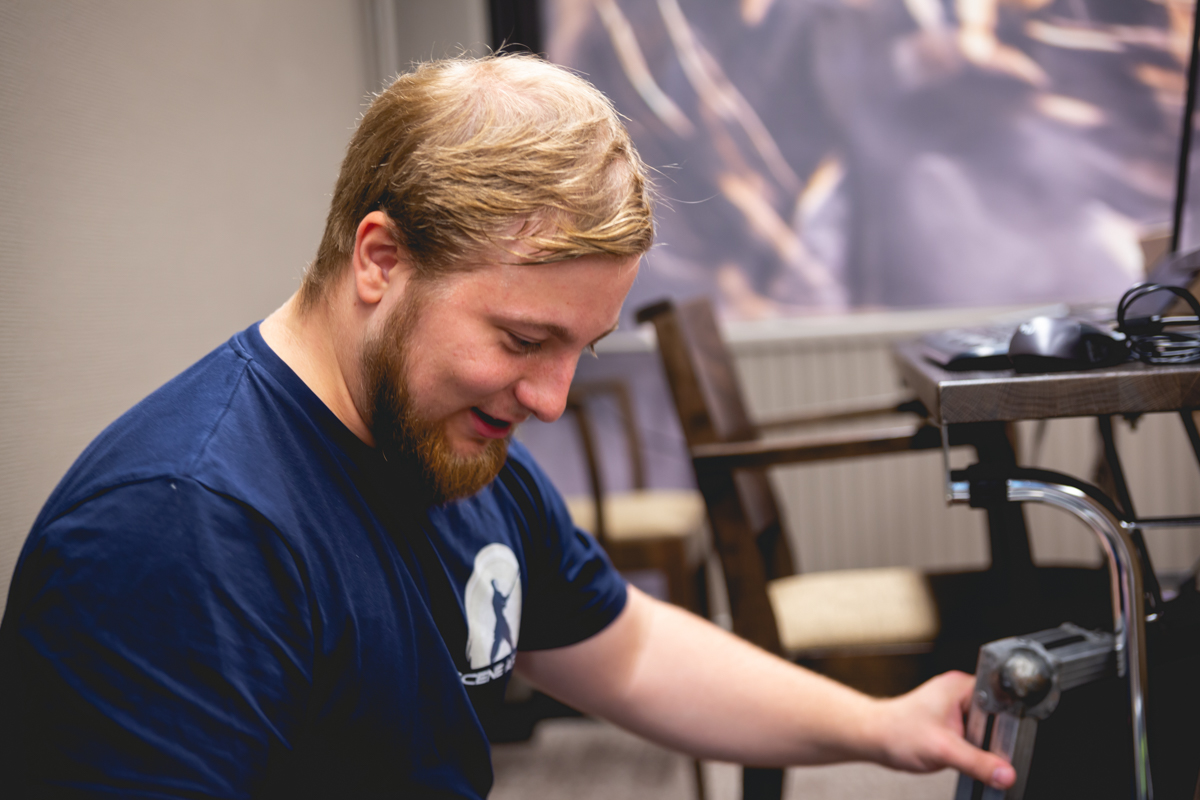
Event production – organising an event and the basics
Organising an event is very much about budget management. Johanna Catani in her book Successful Corporate Event – The Organiser’s Handbook ( Alma Talent, 2017) recommends an approach where 85% of the budget is allocated to actual expenses and 15% is left for contingencies, as situations always change. It is also worth taking into account the different VAT rates (ticket sales, performers’ fees, etc.). Finding financial backers for an event may require a lot of legwork, especially without a background organisation. When seeking sponsorship, it is worth presenting your case as clearly as possible.
The organisation and planning of an event always starts with the space. It is worth making reservations well in advance, as bookings are made for surprisingly long periods of time. It is essential to visit the venue to find out the details of the event, such as logistics, technology, catering and event staff.
Setting a firm date for the event will help significantly with any planning.
Virtual event, hybrid event or live event?
Events can be divided into three categories: traditional events held in a physical venue, virtual events and a combination of the two, known as hybrid events.
The choice of delivery method should be made at the initial stage of production. In practice, organising a hybrid event means organising two events at the same time, and the participant’s experience paths need to be designed separately. Remote participation also sometimes requires quite complex technical arrangements, which the technical supplier will want to know about well in advance.
If you are more interested in organising a virtual event, read our article on organising a webinar.
Event programme
Choosing the programme for your event is certainly one of the most meaningful parts of the planning phase. Often, a large part of the programme is self-generated. If the objective and target group of the event are clearly defined, it is easy to evaluate the content choices and ideas: does the organisation and programme of the event serve the objectives of the event? Content is really the king!
By getting people to participate, i.e. to invest their time in your event, you have probably earned their undivided attention. However, attention will very quickly shift to the wonderful world of, for example, social media, unless you can build a programme that is engaging, flowing and suitably paced.
The role of a competent presenter can hardly be overestimated. A skilful presenter can turn even a very topical event into an experience that the participant will feel is worth his or her time.
Event marketing
Event branding
Every event has a brand, whether you like it or not. That’s why it pays to plan the image you want to communicate to your stakeholders. If the objective of the event and the target audience are clear, building the brand is much easier. Sometimes events have their own brand, and sometimes organising an event explicitly reinforces the brand of the organising organisation. Whatever the situation, image marketing is a skill, and it is worth hiring a professional to achieve excellence. A coherent event brand is directly linked to the target audience’s sometimes subconscious perception of the organisation’s quality, value and professionalism.
The event brand should guide the mood, theme and aesthetic choices in terms of décor and event technology.
Target audiences and channels
At the outset, it is important to define the target audiences. For example, paid social media marketing necessarily requires the creation of customer groups based on a range of demographic criteria and interests. This task is made much easier if the most relevant stakeholders for the success of the event have been identified at the planning stage.
The target groups determine the marketing channels to be considered, depending on the event:
- social media (paid advertising)
- website
- paid advertising (paid advertising), social media (paid advertising), internal communication channels
- print media
- print media within the organisation – billboards, public transport billboards, etc.
- radio / TV
- partners to promote marketing
- events, smaller events, participation in other events
- email marketing
An event marketing professional can tell you which channels to use, when and how much. Our world is now full of advertising, marketing and all kinds of other communications, so standing out is a real challenge. Marketing often involves testing and developing approaches based on the results.
In particular, the algorithms on social media platforms are constantly updating, so making very long marketing plans over time may not be effective. Flexibility is important, especially in the world of soma, but of course you should stay within your overall marketing plan.
Remember to take care of data protection issues. Find out what regulations apply to your marketing.
Event website
The quality image of the event will be significantly enhanced if it has its own website. It makes sense to think of the website as the core of (digital) marketing, supported by other channels. It is not necessarily worth creating a website from scratch, as many event platforms also offer a landing page on the web.
A one-page website is often sufficient to provide concise information about the event. If you want your site to be found on Google for certain keywords, it is worth optimising the site for search engines, and in most cases it is a good idea to consult a professional.
Content production
Invest in continuity and videos. Publications (i.e. posts) and marketing should be steady and continuous. Repeating the same things may seem intrusive, but in reality it’s vital for success. It is said that the same message should reach people in a 7-7-7 manner. When the same message reaches a person seven times from three different marketing channels, you’ve probably got your message across.
In many cases, video is the best content you can produce. A good way is to commission a more polished promotional video package for the sharpest edge of your marketing, backed up with simple phone shots. Self-shooting clips in particular don’t have to be the result of hours of planning, the important thing is that the material is created.
It’s also worth trying to get the whole production team to post behind-the-scenes and behind-the-scenes photos of the preparations on social media channels.
Tip!
A large proportion of people watch somevideos without sound. It is therefore very important that as many videos as possible (especially the more polished ones) have subtitles.
Marketing at the event itself
Organising an event is a good place to market yourself. The public will (hopefully!) pay attention to what the event organiser has chosen. Often, the event’s marketing slots are reserved for sponsors and partners. It is worth taking a moment to analyse the marketing opportunities at an event, as you may not be able to spot excellent opportunities without a moment’s reflection. For example, could there be space in the lobby for product presenters, or could visitors receive an interesting gift card on leaving the event?
Invited guests
You should build a thoughtful guest list for your event. This is where quality beats quantity, and inviting too many people can seem a little generous. On the other hand, we know that not all invited guests are likely to show up. Again, identifying key stakeholders at the planning stage is a great help.
Tip!
Make sure that all guests are aware of the dress code for the event to avoid embarrassing situations.
Event photography, recording and aftermovie
If you want the photos you take at your event to stand the test of time, it’s a good idea to get a professional behind the camera. If the event is a recurring one, the photos will also be an excellent piece of marketing content for future years, and will make it easier to attract sponsors, for example.
If the event is streamed, recording the event at the same time is very cost-effective. Instead of post-production editing, it makes sense to cut the multi-camera production during the event. However, a good practice is to record each camera separately, so that any editing errors can be corrected by post-production editing. In addition to making the recording publicly available, e.g. within the organisation, the recording can be used to produce micro-content, such as short video clips highlighting important points.
The aftermovie is the crown jewel of event content production. An aftermovie is a selling, short and often energetic mood video. Great content for the web and a foolproof choice for marketing your next event.
Order event photography, recording and aftermovie from us!
Aftermovie marketing
Typically, after the event, participants are sent a post-event marketing message, recalling the atmosphere of the event, for example through video or photos. However, the positive buzz wears off very quickly, so after-marketing measures should be taken soon after the event.
Event marketing, event management and data
Throughout the life cycle of an event, the aim is of course to collect as much useful data as possible about the participants, for example to boost sales.
A good event management system will interface with your organisation’s CRM. The aim is to create a situation where attendees are happy to provide data, for example by creating a profile in an engaging event app that includes networking tools, a programme and so on.
It is absolutely worth making the most of the event in terms of participant data, as this may ultimately prove to be the best reward for organising the event.
Remember to take care of data protection regulations!
It is also very important to try to get written feedback from event visitors. Think about how to collect it!
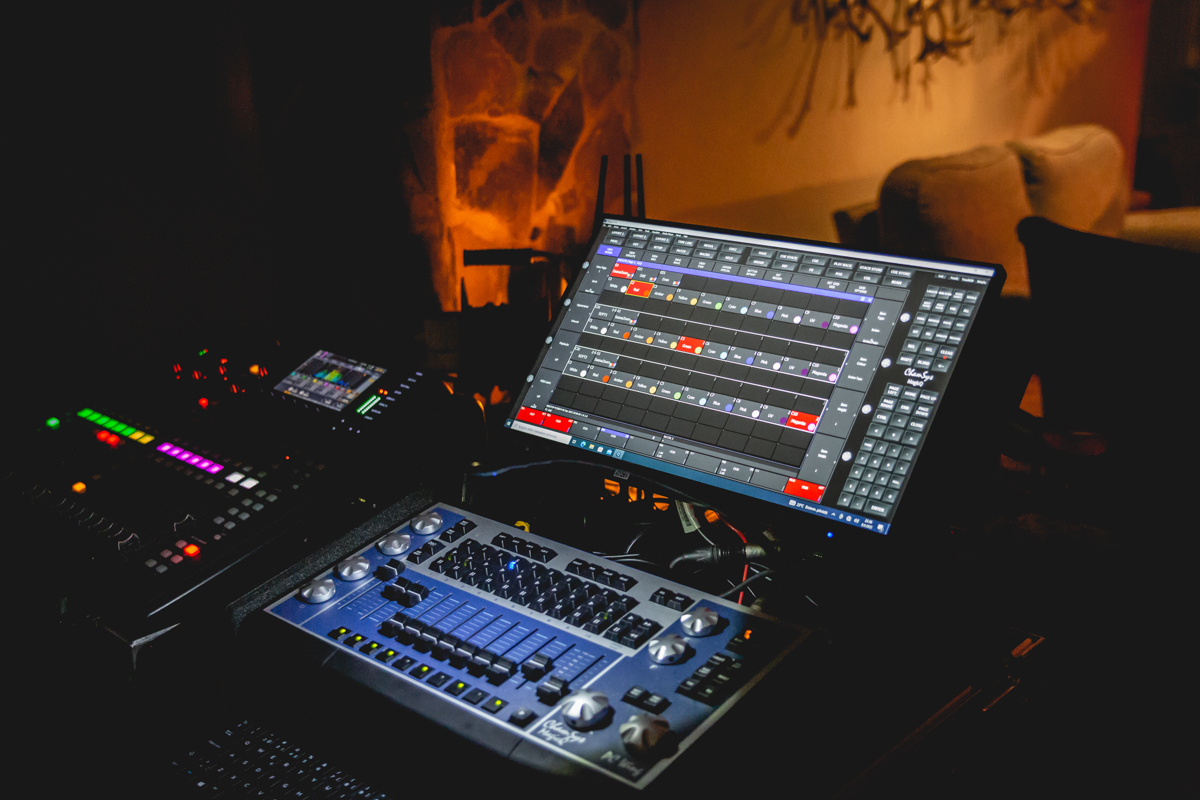
Event management and event technology
Depending on the situation, different digital tools are needed for event management. Apart from the natural role of the producer, for example with a project management application and spreadsheet software, there are specialised platforms for data management of event participants. It is important to try to collect as much and as useful participant information as possible, such as new leads in the CRM system.
The event technology path starts with registration and/or ticketing, the collection of pre-event data and general information (e.g. event page on the web). A good platform provides these on a turnkey basis, and often includes many other useful features in the package. Event technology companies also take care of data protection and security issues, which can be a huge jungle to clear.
Registration systems also often provide powerful tools for gathering feedback. Be sure to take a moment to plan and brainstorm ways to gather feedback. It’s easy to do it the old-fashioned way with a survey, without giving any thought to how valuable the data is. The way you ask questions, when you ask for feedback and, for example, the length of the questionnaire all make a difference.
Event app
The interactivity of the event experience can be enhanced by a digital event platform, or event app. For example, the event platform includes a browser-based application that provides the event programme, speaker information, sponsor locations, live streaming, networking tools and various interactive tools for organising questions and surveys. Another sign of a quality event platform is a mobile app that really works. The event platform harmonises the participant experience between remote and on-site participants.
Order the technical implementation of your event and the event app from us!
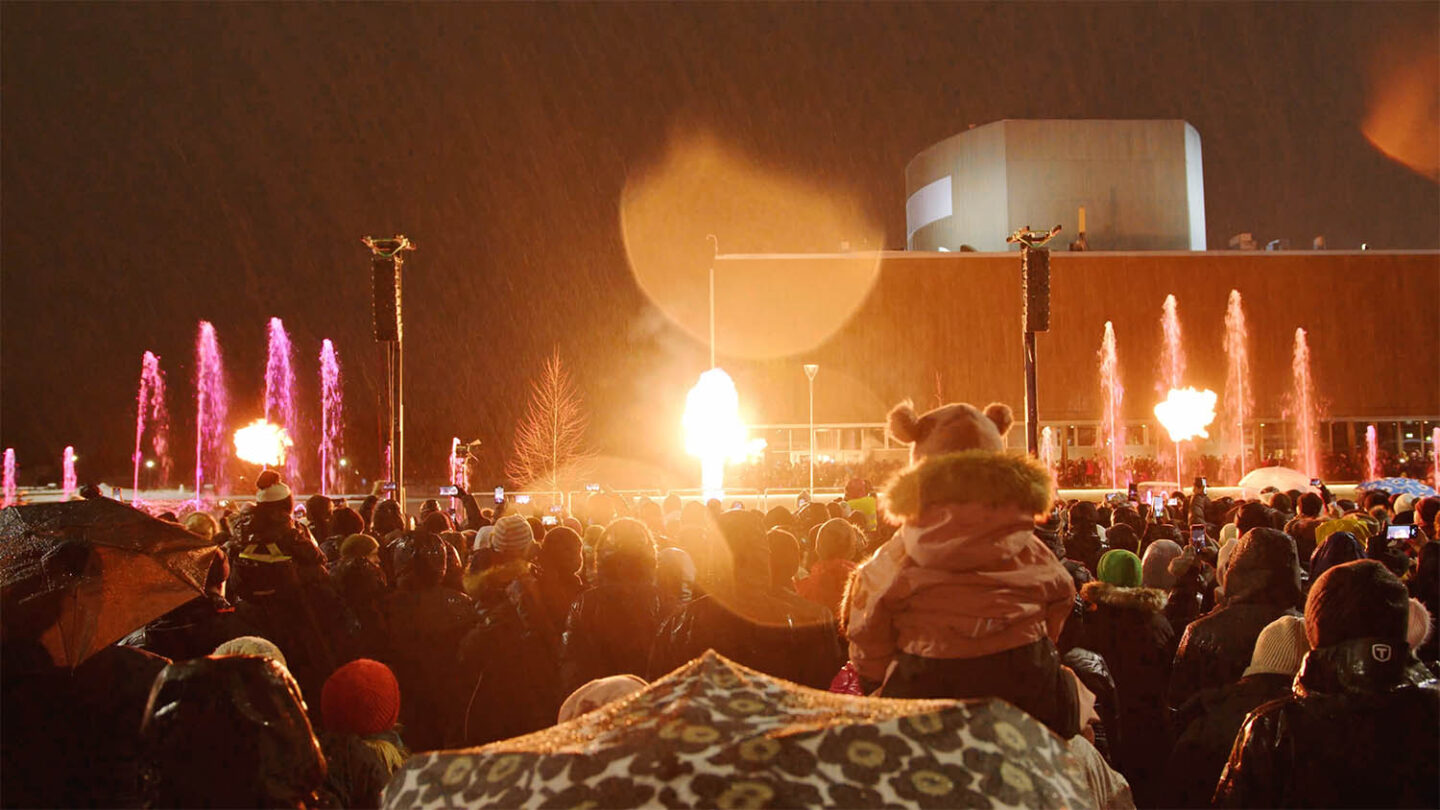
Event Technology
Event technology includes everything from sound, lighting, presentation technology, livestreaming and remote connectivity. Event technology usually works when the audience is not paying attention. However, an event that flows well technically does not happen by accident!
One useful way to visualise the world of event technology is to think of the space as being divided, in the eyes of the technician, into a front of house(FOH) and a stage front. When talking about the FOH, the technician refers to the mixing point in the middle or back of the audience. This is where, for example, the lighting technician and the mixer work, and is often where you will also find the video camera that takes a general view for streaming. Stagehead means the side of the stage where the action is, and where you’ll find a monitor mixer, mixer, video technician, presentation technician and so on.
Tip!
Sometimes you’ll hear mention of FOH left/right or stage left/right. FOH left refers to the left side of the stage as seen from the FOH and stage left refers to the left side of the stage as seen from the presenter on stage.
Event organisation, atmosphere, theme and aesthetics
The mood and aesthetics of an event are determined by the space and its conditions, so it is best to start planning more carefully after you have visited the space. In any case, the atmosphere is a combination of décor, furnishings, set designs, catering, the appearance of the event staff, the energy of the presenter, the content of the event and many other aspects, so it is worth sketching out the whole picture, for example on paper. With these pieces in place, what kind of atmosphere is the event going to have? Are there any particular things that are likely to burst the bubble of an event that stands out from the everyday?
The event technology supplier will play a major role in creating the atmosphere of the event, so it’s worth communicating to the technology people exactly what kind of atmosphere you are looking for. Lighting, background music and projection can make a real difference in any space.
Tip!
Get an interior designer on your event team!

Presentation technology
Presentation technology includes things like video projectors and screens, LED screens, TV screens, slide changers, reference screens for speakers at the front of the stage and video mixers to control the material being presented.
It is important that slideshows, videos and other material to be presented are delivered to the responsible party in good time. Material submitted at the last minute can easily pose a major challenge to the technology and increase the risk of a momentary interruption to the event. While a sudden request to show a video, for example, may seem very simple, it is typical that the person in charge of the technology will have to divert their attention from more important work to making changes. Moreover, video and audio routing are often quite complex entities, where changing one thing can lead to an unfavourable chain reaction. It is therefore possible that the technical team may have to resort to a solution in a hurry that has not been tested and proven to work.
Tip!
If the event is being streamed and you can influence the graphic look of the slideshows, you should ask the streaming provider how the presentations will appear on the stream. If the speaker’s image will appear as a thumbnail in the corner of the slideshow, it is desirable and stylish to leave space in that corner of the slideshow.
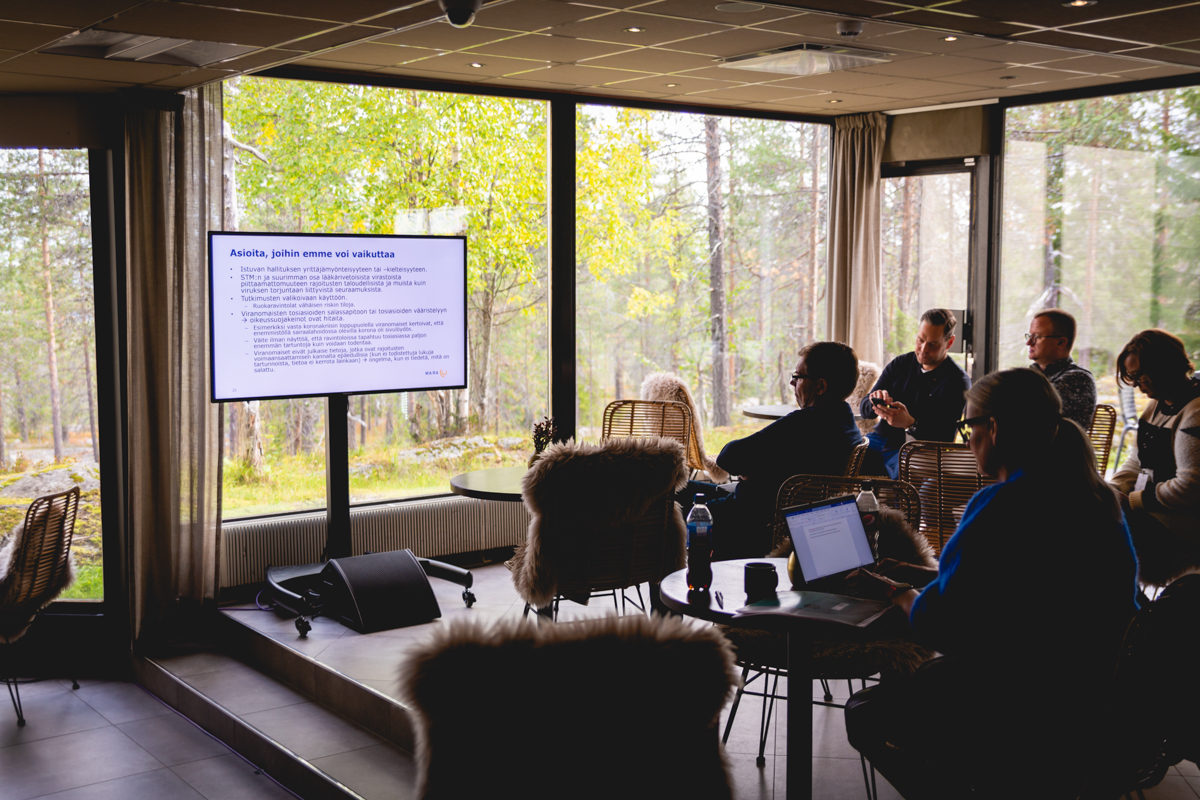
Audio for the event
Typically, the sound system for an event consists of microphones and other sound sources, a mixing desk, the actual sound system (including speakers and their amplifiers) and a large amount of cable. Often there is a stagebox near the stage to which the sound sources from the stage are connected by cables. From the stagebox, the sound travels along a single cable to the mixing desk and vice versa. This avoids a huge amount of cabling between the FOH and the stage.
Once the venue is confirmed (and if the venue does not have an adequate system in place), it is wise to consult the technology supplier about sound reinforcement needs well in advance. A professional will be able to accurately assess the needs, taking into account factors such as the impact of the space on the sound and how much the arrival of the audience will change the sound situation.
If possible, go and check the capability of the room’s sound system yourself. If you can hear the speech clearly, the music sounds pleasant and there is plenty of room to raise the volume, the system is very likely to be adequate.
One essential factor for the clarity of the sound system is that each listener has an unobstructed line of sight to one of the speakers. Lower frequencies are more easily propagated in all directions, but the higher frequencies, which are essential for speech clarity, for example, are quite directional. It is therefore worth trying to get as many participants as possible within the optimum angle of view.
It is important to note that the organisation of the event and the arrangements for remote access also require a separate planning phase for audio. The routing and mixing of outgoing and incoming audio should also be tested, and it is sensible to allow sufficient time for this.
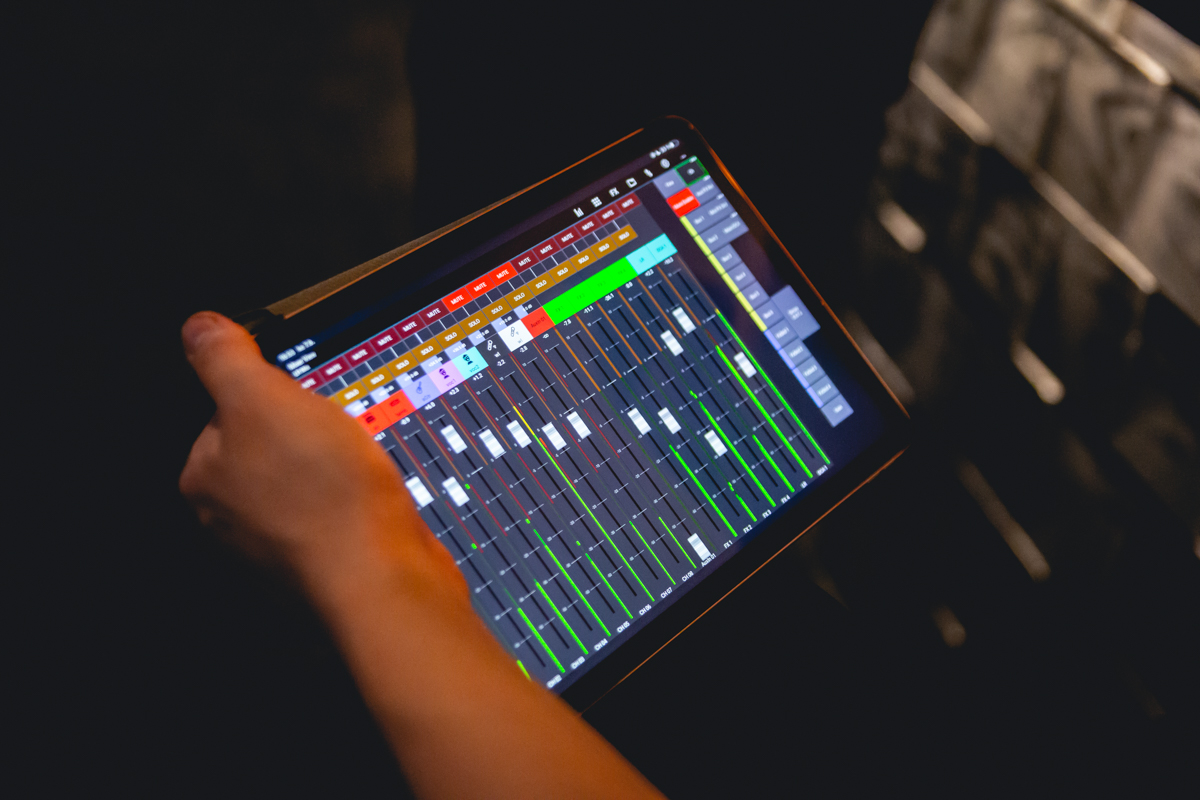
Sound and music
If the event involves music, the sound system will need to be much more sophisticated. The increased monitoring needs of the performers will also add a new dimension to the production, and a separate monitor mixer will be required at the side of the stage to operate the monitoring. A larger sound system consists of subwoofer speakers that reproduce lower frequencies and speakers that reproduce higher frequencies.
In larger venues, there should be a large number of upper-frequency loudspeakers and they should be hung in front of the stage above it. In this case, it is necessary to use smaller frontfill speakers placed at the front of the stage to ensure that the front row can also be heard. In this way, the front row perceives the sound as coming from the stage rather than from the speakers suspended above the stage, giving a much more natural soundstage feel.
Order your event sound system from us!
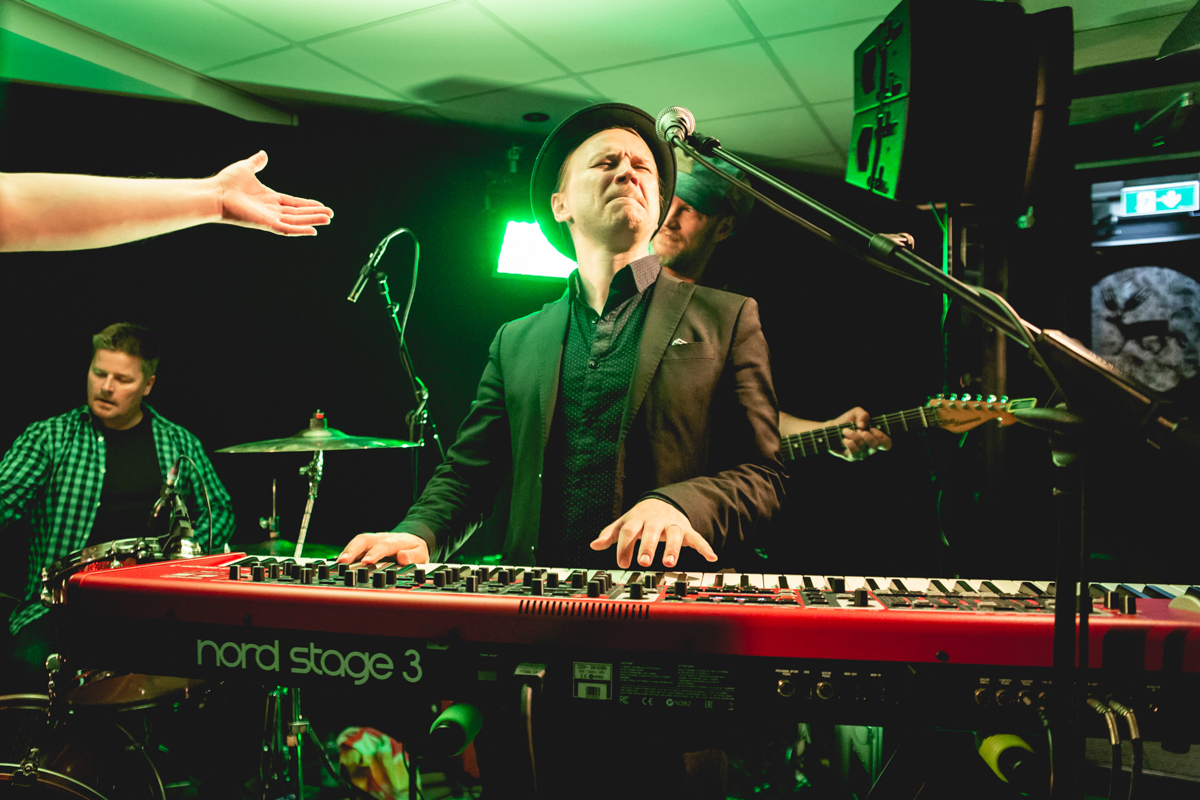
Lighting design and technology
Humans (in general) like light. It’s definitely worth making the most of light’s break from everyday life by associating it with your organisation’s or event’s branding. In addition, light is used to direct the attention of the audience.
Event lighting usually consists of room lighting, general lighting, façade lighting and stage lighting. It is worth discussing with your technical supplier beforehand what kind of package would best serve your event’s objectives. A competent event technician can draw up a model of the space and stage lighting if necessary.
It is important that there are enough lights. Too few in a large space is worse than no lights at all. The role of light is to create an illusion.
The book Color & Light – Navigating Color Mixing in the Midst of an LED Revolution, Handbook for Lighting Designers (Clifton Taylor, Quite Specific Media Group, 2018) identifies four roles for colour choices: storytelling, style, highlighting the ambience and choices of outfit, for example, and creating a sense of depth. Although the book speaks fundamentally about theatrical lighting, it is still generally accepted that in the hands of a skilled designer, the lighting of an event is the sum of considered, visionary and informed choices.
Order lighting design and lighting technology for your event from us!
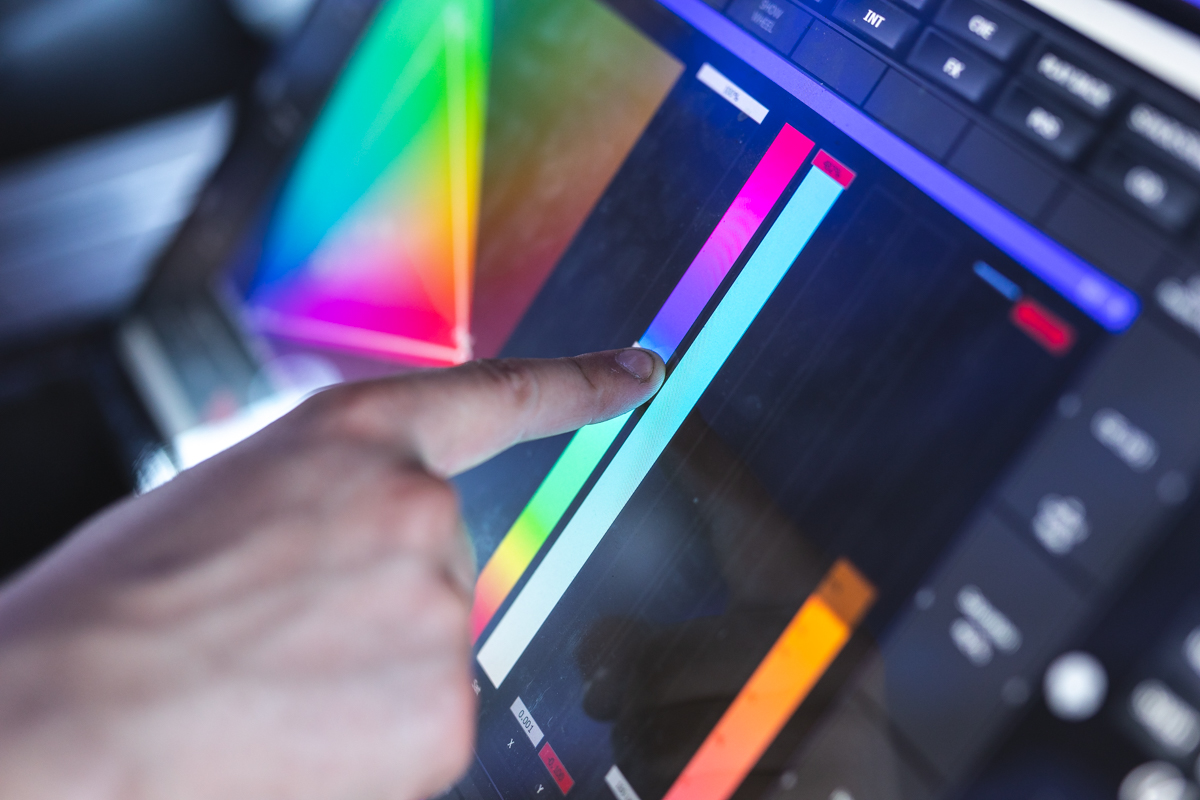
Remote access, remote speakers and streaming
The transmission of images and sound over the network is a delicate business, and the more detailed the implementation plan, the more risks can be eliminated.
A typical remote production of an event consists of the following elements:
- A digital platform for remote speakers to transmit images and sound (e.g. Zoom)
- A digital audio and video platform (e.g., voice-over and video transmission)
- Live streaming, e.g. to YouTube
It is often the case that organising one of these is quite straightforward. Almost anyone can create a Zoom event or get a PowerPoint presentation from their computer to appear on a video projector using an HDMI cable. The implementation becomes exponentially more complex if you need to combine the components. For example, how do you prevent a situation where the audience following the stream can’t hear the speaker’s mic, but the microphone in the room is already too loud? Or how do you get the remote speaker’s picture on the room’s video screen without cursors, toolbars or thumbnails of other speakers?
We recommend that you turn to a professional for remote connectivity arrangements, as the functionality of the connections and the enjoyment of watching the stream are directly linked to your perception of the quality of your organisation.
Order remote access and streaming services for your event from us!
Stage and structures
Organising a larger programme-oriented event requires a stage as a prerequisite to ensure that the attendees’ attention is focused on the right things. The stage itself reinforces the persuasiveness of the speaker’s presentation. Its existence is also very practical, for example in terms of technology.
The stage is made up of, among other things, the following elements:
- The deck is a 2 x 1 metre piece of wood from which the stage is built. Underneath the stage are legs of different lengths as required. Often the height of the stage is about 1 metre. The platform pieces are attached to each other in one way or another.
- The stage is usually surrounded by a black skirting so that the audience does not see the ugly stage legs.
- A stage staircase and a ramp (for varying needs) as well as fencing are often part of the stage.
- Depending on the space, truss lines, to which lighting and sound equipment, for example, are attached, can be suspended either from suspension points in the ceiling or from a sturdy support structure built around the stage, the supporter (the poles on which the truss frame rests), on which the truss lines containing the equipment are suspended.
- For a smaller implementation, no suspension points or support are needed, but the truss lines can also be lifted to the front and back of the stage by means of mobile cranes.
- Often the back of the stage is covered with black fireproof molton fabric, which can be referred to as backdrop.
- In larger stage implementations, backdrops are provided on the sides and front of the stage to screen the public from view, for example, from the technical team working near the stage and from the movement of equipment.
- Typically, large stages have screens or LED screens at both the back and sides of the stage.
Tip!
If you have to build a support around the stage, you will very likely have to pay more. Sufficiently strong hanging points in the space are inherently kinder to your wallet.
It is also possible that other structures will be required for the wick, which the technical contractor will supply if necessary. For example, structural solutions for display and lighting fall into this category.
Event security
For very small events, security is not a major concern, but as the number of people increases, event security quickly becomes a very important issue. When planning an event, we recommend that you contact an event security service provider or event agency to ensure that the often complex security processes are correct. If the event is taking place at a venue where events are usually held, the first place to consult on security issues is the venue hire company. Venues will often have handled security issues for you.
Event security covers many aspects, such as crowd control, security, fire safety, stage security, first aid, emergency evacuation, mandatory notifications to the authorities, permit applications and so on. Security also includes various insurance policies and responsibilities, which should be familiarised with and agreed with the various parties involved.
Please contact a professional if you are not sure how to proceed!
Responsibility issues in event production have become more and more important in recent years, and rightly so. The environmental and social impact of events has started to be monitored and measured, and sometimes this is reflected in higher prices for various services. It is highly advisable to pay attention to the sustainability of your event, as this is also of increasing interest to event visitors. By creating measurable sustainability objectives, you can also communicate them to the public and promote a positive image.
Tip!
Events are always a highlight in the lives of people and their organisers. Especially close to the event, it is easy to find the motivation to extend working days and squeeze every last ounce of juice out of the workforce, but especially for subcontractors, it is important to remember that they are doing events for a living. It is clear that the choice of occupation leads to long working days on event weekends. This is compensated for in terms of earnings, but it is still useful to realise that people working on events are not able to stretch themselves from week to week and event to event to work to the detriment of their long-term well-being. A responsible contractor will be able to set reasonable limits on the workload of its employees and prioritise important issues, while still ensuring effective customer service and security of supply.
Event production – other issues
When selecting event workers and/or managers, it’s best to look for people with a customer service focus. Audiences or performers may not know the job roles of event staff, contractors or volunteers, so it is important that everyone has the right attitude. “It’s none of my business” is not conducive to an excellent event experience.
Larger events, in particular, draw on volunteers who want to be involved in the event just to get in on the action, surrounded by a theme that interests them. Special attention must be paid to the volunteers, with special care for breaks, meals and the general atmosphere.
A handshake of thanks really means a lot. Volunteers and event staff are the mouthpiece of your event and the sharp edge of your bush radio marketing.
Event furnitures
If your event space doesn’t provide a sufficient amount of event furniture, it’s a good idea to find a local furniture partner. Event furniture should be booked well in advance and, if possible, checked in advance. If you are not quite sure, for example, what number of tables would be suitable for a particular number of people in a particular space, your furniture partner can also provide a complete solution on request. It is very likely that a local event furniture supplier will have worked in the venue before.
Catering
The value of an event to the visitor increases when food is available. Catering defines the quality image of your event, and quite a few people subconsciously rhythm the flow of their event around coffee and lunch breaks.
It is particularly important to ensure that the quality of the food meets or, where appropriate, exceeds the expectations of the event visitor.
If your venue does not offer catering services, it is strongly recommended that you contact a local professional. Handling food, booking the right amount to avoid wastage or premature consumption, and many other considerations make this an area where you will want to source from a professional in the first place.
Dinners and cafes are sure to be one of the make it or break it moments of your event!
Logistics
Naturally, it is necessary to consider the availability of parking spaces around the venue and the accessibility of the event by public transport. It is worth thinking about how you would plan to arrive at the event and how you could make getting around as easy as possible. If necessary, it may be sensible to ask your local taxi company to arrange a temporary taxi stand.
Technology suppliers, event equipment suppliers, caterers and the like will also need parking spaces and clear instructions on where to arrange for the transport of equipment, i.e. where it will be dumped. Do your best to avoid stairs, narrow doorways, high thresholds and potentially breakable glass walls. It is also advisable, if necessary, to schedule the loading times of the various subcontractors so as to avoid congestion on the loading docks.
Accommodation
For multi-day events, it is often necessary to arrange accommodation for participants. Local hotels are usually very willing to cooperate in these cases. It is also worth considering how visitors will get from the venue to the hotel and back.
The accommodation needs of the event’s subcontractors should also be taken into account. It is worth checking whether the subcontractor has included travel and accommodation in its offer, or whether it expects to receive it from the event organiser.
Event organiser
Of course, this article is just a glimpse into the world of event organisation, and there are several important things that I missed. But I hope you’ve got some food for thought and some starting points for organising your own event – something to get you started!
